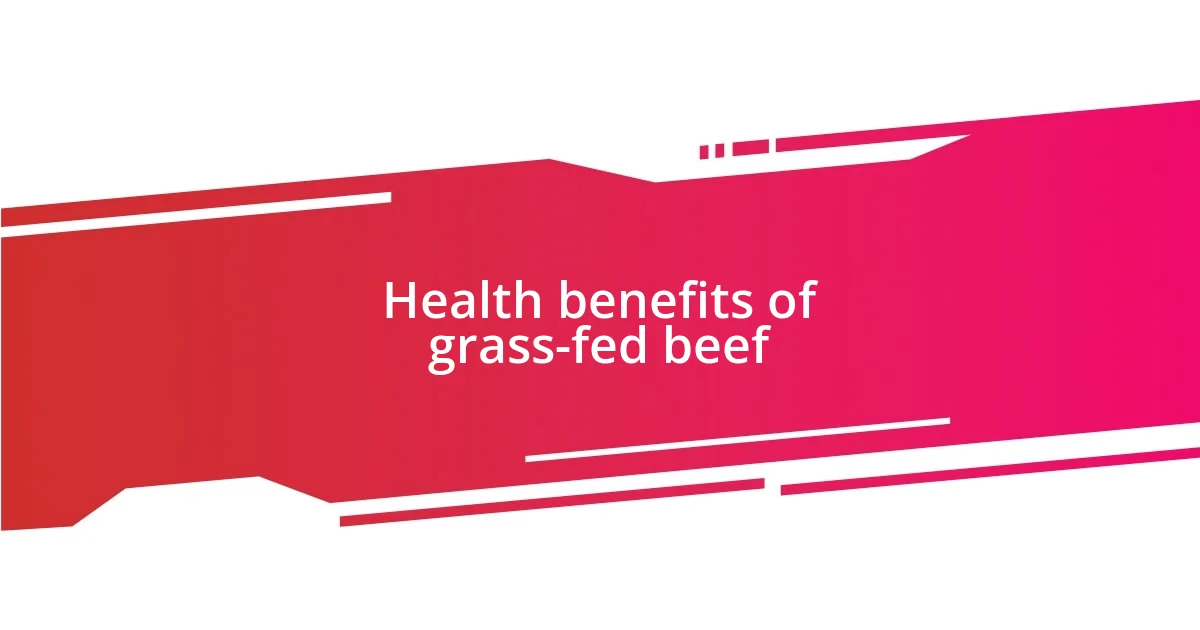Key takeaways:
- Grass-fed beef offers superior nutritional benefits, including higher omega-3 fatty acids, vitamins A and E, and fewer calories compared to grain-fed beef.
- Environmental impacts of cattle farming, such as deforestation and greenhouse gas emissions, highlight the importance of sustainable beef choices that can lower these effects.
- The price of grass-fed beef is higher, but seen as an investment in health and well-being; consumers must balance cost with nutritional and environmental benefits.

Understanding beef production methods
Beef production methods can be broadly categorized into grass-fed and grain-fed systems, each having distinct practices and philosophies. Reflecting on my visits to various farms, I often found myself amazed at how the environment shapes cattle diets. Have you ever considered how a cow raised on lush, green pastures contrasts with one fed a diet of corn and soy? It’s striking.
In my experience, grass-fed beef typically has a richer flavor and more nutritional benefits, largely stemming from the animal’s natural diet. I remember the first time I tried a grass-fed steak—it was like a revelation! The tenderness and depth of flavor made me ponder how much the animal’s feed influences not just taste but also health.
On the flip side, grain-fed beef tends to reach market weight faster, making it appealing economically. I can understand why producers opt for this method; it’s efficient and often more profitable. Yet, I can’t shake off the feeling that this efficiency sometimes comes at a cost, not only for the cattle but also for the quality of the beef we consume. How do we balance cost and quality in a way that’s sustainable for both the industry and our health?

Nutrition differences in beef types
When exploring the nutritional differences between grass-fed and grain-fed beef, I’ve often noticed that the impact on health is substantial. For example, grass-fed beef is generally higher in omega-3 fatty acids, which are essential for heart health. The first time I came across this fact, I was surprised; I never thought the cow’s diet could affect the unhealthy fats and cholesterol levels in the meat. It all ties back to how a cow’s natural feeding habits can enhance what we put on our plates.
Here are some key nutritional differences:
- Omega-3 fatty acids: Grass-fed beef has significantly higher levels, contributing to heart health.
- Omega-6 fatty acids: Grain-fed beef typically has more, which can lead to inflammation if consumed in excess.
- Vitamins: Grass-fed beef tends to have more vitamins A and E, which are vital for immune function and skin health.
- Antioxidants: Higher levels of antioxidants like conjugated linoleic acid (CLA) found in grass-fed beef may help reduce the risk of certain diseases.
- Calories: Grass-fed beef is generally leaner, providing fewer calories compared to its grain-fed counterpart.
These differences made me realize how much we need to consider not just what we eat, but where it comes from and the journey it took to reach our tables. I’ve become more conscious of selecting beef that aligns with my values and health goals, and these differences are a big part of that decision-making process.

Health benefits of grass-fed beef
Grass-fed beef is truly remarkable when considering its health benefits. From my experience, one of the standout features is its higher omega-3 fatty acid content. Last summer, I tried a grass-fed burger at a local farm-to-table restaurant, and the difference was palpable. With every bite, I felt satisfied not just by the flavor, but knowing I was indulging in something that might truly benefit my heart health.
What really struck me during my research is the abundance of vitamins in grass-fed beef—especially vitamins A and E. A couple of months ago, while chatting with a nutritionist friend, they shared that these vitamins play a crucial role in maintaining immune function and skin health. It dawned on me that by choosing grass-fed, I wasn’t only supporting local farmers but also enriching my diet. It reframed my perspective on purchases; every time I opt for grass-fed, I’m making a choice that resonates with my health values.
Interestingly, grass-fed beef is also leaner, translating to fewer calories. I recall when I switched to grass-fed beef for my tacos—a filling meal, yet I didn’t feel that post-meal sluggishness I usually got. It’s those little surprises that reinforce my appreciation for this natural choice. The benefits are tangible, and it’s exciting to know that a simple dietary decision can have such a profound impact on overall well-being.
| Health Benefit | Grass-Fed Beef |
|---|---|
| Omega-3 Fatty Acids | Higher levels for heart health |
| Vitamins | More Vitamins A and E |
| Antioxidants | Higher levels of CLA |
| Calories | Leaner, fewer calories |

Environmental impacts of cattle farming
Cattle farming significantly impacts the environment, and it’s something I’ve thought about quite a bit. For instance, raising cattle, especially in large numbers, often leads to deforestation activities. I remember reading a study that stated extensive cattle ranching has contributed to the loss of vast forest areas, particularly in the Amazon. Isn’t it astounding how our beef choices can ripple through entire ecosystems?
Additionally, manure management can be a challenge in conventional cattle farming. The waste produced can contaminate water sources, leading to harmful algal blooms and negatively affecting aquatic life. I once visited a local farm that implemented better waste management practices, turning manure into fertilizer instead of letting it pollute; it was enlightening to see how positive changes could offset such environmental issues.
Moreover, the greenhouse gas emissions associated with cattle farming caught my attention too. Cows emit methane, a potent greenhouse gas, during digestion. I can’t help but wonder how our dietary choices could collectively shape a more sustainable future. The idea that opting for grass-fed beef might contribute to lower emissions makes me feel more proactive about my food choices—it’s a small step, but one that resonates with my values on sustainability.

Taste comparisons between beef types
When it comes to taste, there’s a distinct difference between grass-fed and grain-fed beef. I still remember the first time I bit into a grass-fed steak; it had this rich, earthy flavor that felt more organic and so much more satisfying than the grain-fed cuts I’d had in the past. It’s as if the taste brought the essence of the pasture directly to my plate—there’s a vibrant, almost wild quality that really shines through.
Conversely, grain-fed beef tends to have a milder, more buttery flavor profile. It’s certainly flavorful in its own right, but I’ve found that its taste can sometimes feel one-dimensional. One evening, while grilling burgers with friends, we whipped up a side-by-side tasting of both beef types. Everyone agreed that the grass-fed burgers offered a complexity that made the grain-fed version seem a bit bland. That moment reaffirmed for me just how much the source of our food can shape our culinary experiences.
It’s also intriguing to consider how the cooking method can amplify these differences. When I seared a grass-fed ribeye, the marbling rendered beautifully, allowing for a caramelized crust that made my taste buds dance. Have you ever thought about how the animal’s diet might influence cooking time and temperature too? I learned that grass-fed beef often cooks faster because it’s leaner, which is a tip I now keep in mind to prevent overcooking. It’s this kind of exploration that has made me more aware of how every bite tells a story—in flavor and nutrition.

Cost considerations for consumers
The cost of grass-fed versus grain-fed beef is a hot topic among consumers. Personally, I’ve noticed that grass-fed beef typically carries a higher price tag, which can be a deterrent for many. When I first switched to grass-fed, I hesitated at the checkout, wondering if the taste and perceived health benefits were worth the extra dollars. Have you ever faced the same dilemma?
Interestingly, while grass-fed might be more expensive upfront, I’ve started to view it as an investment in my health and the environment. For instance, after switching, I’ve felt more energized and focused. This made me reflect—what if these healthier choices could lead to fewer medical bills in the long run? It’s a thought that truly reshapes how I budget for groceries.
On the other hand, grain-fed beef is often more accessible, appealing to those who are feeding families on a budget. I often think about my friends who are juggling multiple commitments; they might prioritize saving money over possible health advantages. Yet, I can’t help but feel that, in the grand scheme of things, spending a little more might yield richer rewards—like supporting sustainable farming practices that align with my values. How do you decide what’s worth the cost when it comes to your food choices?















